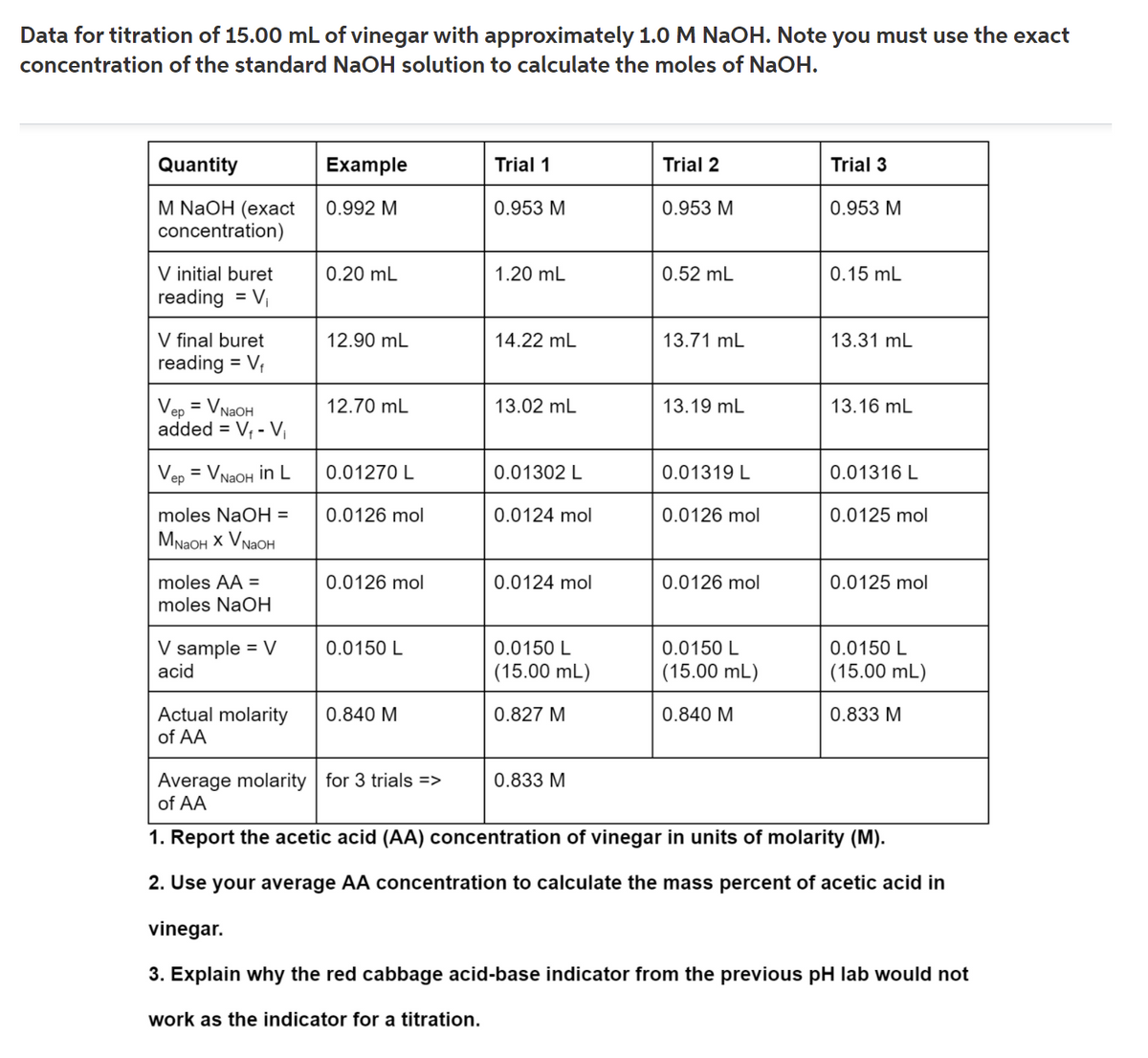Data for titration of 15.00 mL of vinegar with approximately 1.0 M NaOH. Note you must use the exact concentration of the standard NaOH solution to calculate the moles of NaOH. Quantity Example Trial 1 Trial 2 Trial 3 M NaOH (еxact concentration) 0.992 M 0.953 M 0.953 M 0.953 M V initial buret reading = V, 0.20 mL 1.20 mL 0.52 mL 0.15 mL V final buret reading = V, 12.90 mL 14.22 mL 13.71 mL 13.31 mL Vep = VNAOH 12.70 mL 13.02 mL 13.19 mL 13.16 mL added = V, - Vi Vep 3 VNaoн in L 0.01270 L 0.01302 L 0.01319 L 0.01316 L moles NaOH = MNAOH X VNAOH 0.0126 mol 0.0124 mol 0.0126 mol 0.0125 mol moles AA = moles NaOH 0.0126 mol 0.0124 mol 0.0126 mol 0.0125 mol V sample = V acid 0.0150 L 0.0150 L 0.0150 L 0.0150 L (15.00 mL) (15.00 mL) (15.00 mL) Actual molarity of AA 0.840 M 0.827 M 0.840 M 0.833 M Average molarity for 3 trials => of AA 0.833 M 1. Report the acetic acid (AA) concentration of vinegar in units of molarity (M). 2. Use your average AA concentration to calculate the mass percent of acetic acid in vinegar. 3. Explain why the red cabbage acid-base indicator from the previous pH lab would not work as the indicator for a titration.
Data for titration of 15.00 mL of vinegar with approximately 1.0 M NaOH. Note you must use the exact concentration of the standard NaOH solution to calculate the moles of NaOH. Quantity Example Trial 1 Trial 2 Trial 3 M NaOH (еxact concentration) 0.992 M 0.953 M 0.953 M 0.953 M V initial buret reading = V, 0.20 mL 1.20 mL 0.52 mL 0.15 mL V final buret reading = V, 12.90 mL 14.22 mL 13.71 mL 13.31 mL Vep = VNAOH 12.70 mL 13.02 mL 13.19 mL 13.16 mL added = V, - Vi Vep 3 VNaoн in L 0.01270 L 0.01302 L 0.01319 L 0.01316 L moles NaOH = MNAOH X VNAOH 0.0126 mol 0.0124 mol 0.0126 mol 0.0125 mol moles AA = moles NaOH 0.0126 mol 0.0124 mol 0.0126 mol 0.0125 mol V sample = V acid 0.0150 L 0.0150 L 0.0150 L 0.0150 L (15.00 mL) (15.00 mL) (15.00 mL) Actual molarity of AA 0.840 M 0.827 M 0.840 M 0.833 M Average molarity for 3 trials => of AA 0.833 M 1. Report the acetic acid (AA) concentration of vinegar in units of molarity (M). 2. Use your average AA concentration to calculate the mass percent of acetic acid in vinegar. 3. Explain why the red cabbage acid-base indicator from the previous pH lab would not work as the indicator for a titration.
Chemistry: Principles and Reactions
8th Edition
ISBN:9781305079373
Author:William L. Masterton, Cecile N. Hurley
Publisher:William L. Masterton, Cecile N. Hurley
Chapter14: Equilibria In Acid-base Solutions
Section: Chapter Questions
Problem 74QAP: Fifty cm3 of 1.000 M nitrous acid is titrated with 0.850 M NaOH. What is the pH of the solution (a)...
Related questions
Question

Transcribed Image Text:Data for titration of 15.00 mL of vinegar with approximately 1.0 M NaOH. Note you must use the exact
concentration of the standard NaOH solution to calculate the moles of NaOH.
Quantity
Еxample
Trial 1
Trial 2
Trial 3
M NaOH (exact
concentration)
0.992 M
0.953 M
0.953 M
0.953 M
V initial buret
reading = V,
0.20 mL
1.20 mL
0.52 mL
0.15 mL
V final buret
reading = V,
12.90 mL
14.22 mL
13.71 mL
13.31 mL
%3D
Vep = VNAOH
added = V; - V,
12.70 mL
13.02 mL
13.19 mL
13.16 mL
Vep = VNAOH in L
0.01270 L
0.01302 L
0.01319 L
0.01316 L
moles NaOH =
0.0126 mol
0.0124 mol
0.0126 mol
0.0125 mol
MNAOH X VNAOH
moles AA =
0.0126 mol
0.0124 mol
0.0126 mol
0.0125 mol
moles NaOH
V sample = V
acid
0.0150 L
0.0150 L
0.0150 L
0.0150 L
(15.00 mL)
(15.00 mL)
(15.00 mL)
Actual molarity
0.840 M
0.827 M
0.840 M
0.833 M
of AA
Average molarity for 3 trials =>
of AA
0.833 M
1. Report the acetic acid (AA) concentration of vinegar in units of molarity (M).
2. Use your average AA concentration to calculate the mass percent of acetic acid in
vinegar.
3. Explain why the red cabbage acid-base indicator from the previous pH lab would not
work as the indicator for a titration.
Expert Solution
This question has been solved!
Explore an expertly crafted, step-by-step solution for a thorough understanding of key concepts.
This is a popular solution!
Trending now
This is a popular solution!
Step by step
Solved in 4 steps

Knowledge Booster
Learn more about
Need a deep-dive on the concept behind this application? Look no further. Learn more about this topic, chemistry and related others by exploring similar questions and additional content below.Recommended textbooks for you

Chemistry: Principles and Reactions
Chemistry
ISBN:
9781305079373
Author:
William L. Masterton, Cecile N. Hurley
Publisher:
Cengage Learning

Chemistry: The Molecular Science
Chemistry
ISBN:
9781285199047
Author:
John W. Moore, Conrad L. Stanitski
Publisher:
Cengage Learning

Chemical Principles in the Laboratory
Chemistry
ISBN:
9781305264434
Author:
Emil Slowinski, Wayne C. Wolsey, Robert Rossi
Publisher:
Brooks Cole

Chemistry: Principles and Reactions
Chemistry
ISBN:
9781305079373
Author:
William L. Masterton, Cecile N. Hurley
Publisher:
Cengage Learning

Chemistry: The Molecular Science
Chemistry
ISBN:
9781285199047
Author:
John W. Moore, Conrad L. Stanitski
Publisher:
Cengage Learning

Chemical Principles in the Laboratory
Chemistry
ISBN:
9781305264434
Author:
Emil Slowinski, Wayne C. Wolsey, Robert Rossi
Publisher:
Brooks Cole

Chemistry
Chemistry
ISBN:
9781305957404
Author:
Steven S. Zumdahl, Susan A. Zumdahl, Donald J. DeCoste
Publisher:
Cengage Learning

Chemistry: An Atoms First Approach
Chemistry
ISBN:
9781305079243
Author:
Steven S. Zumdahl, Susan A. Zumdahl
Publisher:
Cengage Learning
